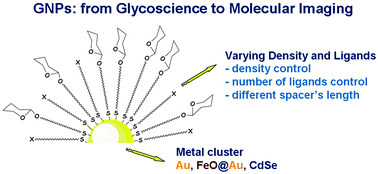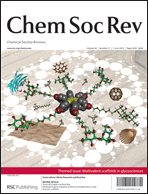The quest for the construction of multivalent carbohydrate systems, with precise geometries that are highly efficient in interacting with carbohydrate binding proteins, has been a goal of synthetic chemists since the discovery of the multivalent nature of carbohydrate-mediated interactions. However, the control of the spatial and topological requirements for these systems is still a challenge. Glyconanoparticles (GNPs) are sugar-coated gold, iron oxide or semiconductor nanoparticles with defined thiol-ending glycosides that combine the multivalent presentation of carbohydrates (glycoclusters) with the special chemico-physical properties of the nano-sized metallic core. The possibility of attaching different types of carbohydrates and other molecules (such as luminescent probes, peptides, and magnetic chelates) onto the same gold nanoparticle in a controlled way (multifunctional GNPs), as well as modifying the core in order to obtain glyconanoparticles with magnetic or fluorescence properties (multimodal GNPs) makes this multivalent glyco-scaffold suitable for carrying out studies on carbohydrate-mediated interactions and applications in molecular imaging. In this review, we focus mainly on the rational design of glyconanoparticles as scaffolds for combining different ligands and survey the most recent examples of glyconanoparticles as both multivalent carbohydrate systems and probes for molecular imaging.

You have access to this article
 Please wait while we load your content...
Something went wrong. Try again?
Please wait while we load your content...
Something went wrong. Try again?


 Please wait while we load your content...
Please wait while we load your content...